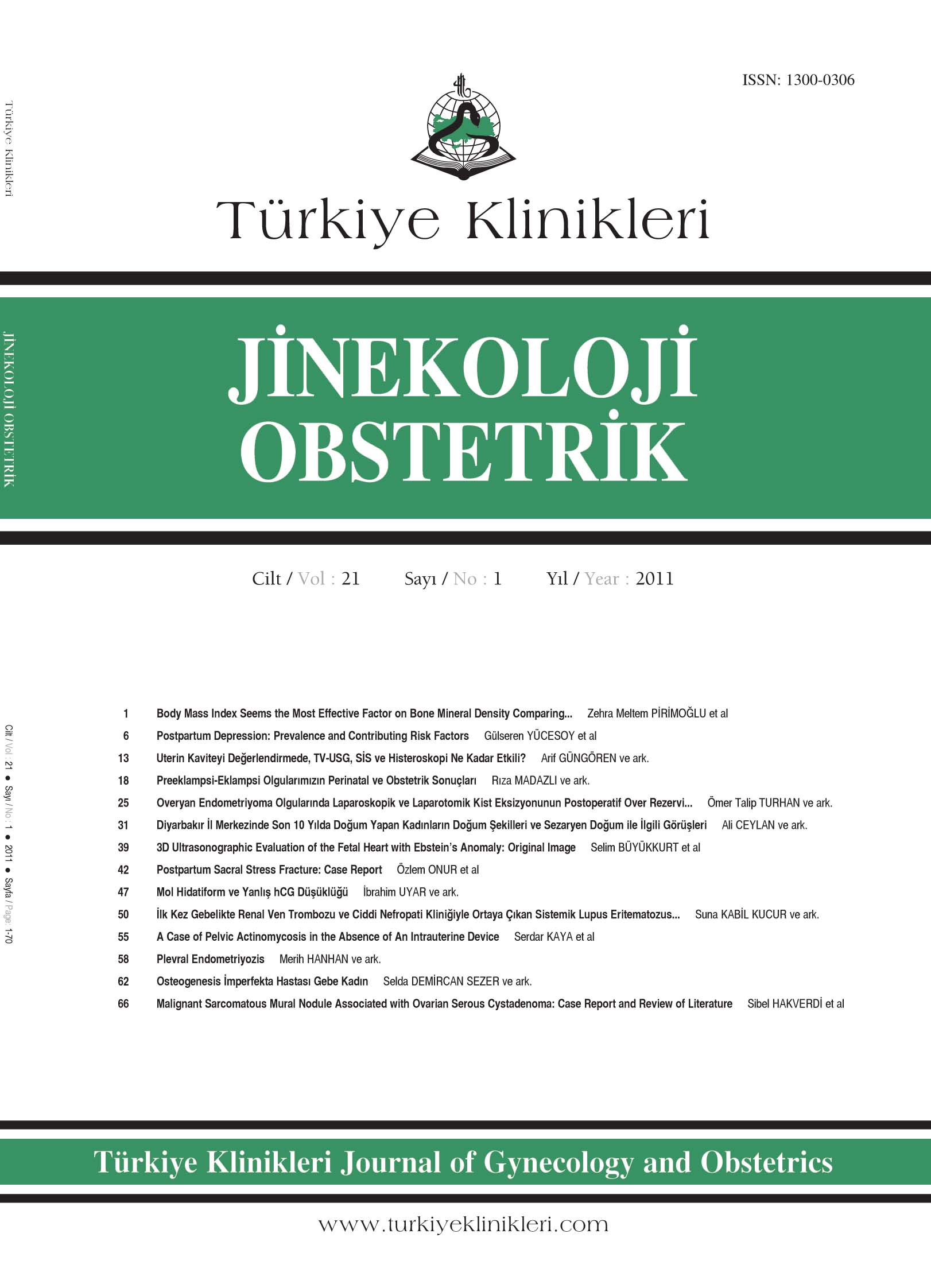Open Access
Peer Reviewed
ORIGINAL RESEARCH
2642 Viewed1223 Downloaded
Postpartum Depression: Prevalence and Contributing Risk Factors
Postpartum Depresyon: Prevalans ve Risk Faktörleri
Turkiye Klinikleri J Gynecol Obst. 2011;21(1):6-12
Article Language: EN
Copyright Ⓒ 2025 by Türkiye Klinikleri. This is an open access article under the CC BY-NC-ND license (http://creativecommons.org/licenses/by-nc-nd/4.0/)
ABSTRACT
Objective: To determine the prevalence and to assess the contributing risk factors of postpartum depression in an urban population. Material and Methods: A prospective study involving postpartum women was conducted at a tertiary medical center in order to determine the individuals with depressive symptomatology. Three different depression scales namely Edinburgh Postnatal Depression Scale, Beck Depression Inventory, and Hamilton Depression Rating Scale were used. The scales were administered twice, in the first and sixth week after the delivery. Prevalance of postpartum depression and associated risk factors such as sociodemographic, psychological, and pregnancy-labour related parameters were evaluated. Results: In 123 postpartum women, the prevalence of postpartum depression according to the results of three different depression scales was 9.8-30.1% in the first week, and was reduced to 6.5-16.3% at the postpartum sixth week. Eight (6.5%) women have exhibited postpartum depression according to the scores of all three scales at the same time during the second evaluation. Low family income, severe intrafamilial conflict and personal history of psychiatric treatment were related with depressive symptomatology, and these risk factors were detected among the women who scored positively according to the scores of all three scales at the postpartum sixth week (p= 0.007, p= 0.021, p= 0.024 respectively). Conclusion: Better understanding of risk factors leading to postpartum depression is mandatory for health care providers to recognize this significant psychiatric disorder at an early stage. Screening by using various scales should be encouraged for timely detection of vulnerable women.
Objective: To determine the prevalence and to assess the contributing risk factors of postpartum depression in an urban population. Material and Methods: A prospective study involving postpartum women was conducted at a tertiary medical center in order to determine the individuals with depressive symptomatology. Three different depression scales namely Edinburgh Postnatal Depression Scale, Beck Depression Inventory, and Hamilton Depression Rating Scale were used. The scales were administered twice, in the first and sixth week after the delivery. Prevalance of postpartum depression and associated risk factors such as sociodemographic, psychological, and pregnancy-labour related parameters were evaluated. Results: In 123 postpartum women, the prevalence of postpartum depression according to the results of three different depression scales was 9.8-30.1% in the first week, and was reduced to 6.5-16.3% at the postpartum sixth week. Eight (6.5%) women have exhibited postpartum depression according to the scores of all three scales at the same time during the second evaluation. Low family income, severe intrafamilial conflict and personal history of psychiatric treatment were related with depressive symptomatology, and these risk factors were detected among the women who scored positively according to the scores of all three scales at the postpartum sixth week (p= 0.007, p= 0.021, p= 0.024 respectively). Conclusion: Better understanding of risk factors leading to postpartum depression is mandatory for health care providers to recognize this significant psychiatric disorder at an early stage. Screening by using various scales should be encouraged for timely detection of vulnerable women.
ÖZET
Amaç: Kentsel bir popülasyonda postpartum depresyon prevalansı ve risk faktörlerinin belirlenmesidir. Gereç ve Yöntemler: Postpartum kadınlarda depresif semptomları olan bireyleri belirlemek üzere tersiyer merkezde prospektif bir çalışma yürütüldü. Edinburg Postnatal Depresyon Ölçeği, Beck Depresyon Ölçeği ve Hamilton Depresyon Ölçeği olmak üzere üç farklı depresyon ölçeği kullanıldı. Ölçekler doğum sonrası birinci ve altıncı haftada olmak üzere iki kez uygulandı. Postpartum depresyon prevalansı ve sosyodemografik, fizyolojik ve gebelik-doğumla ilişkili parametreler gibi eşlik eden risk faktörleri değerlendirildi. Bulgular: 123 postpartum kadında, üç farklı depresyon ölçeğinin sonuçlarına göre postpartum depresyon prevalansı birinci haftada %9.8-30.1den postpartum altıncı haftada %6.5-16.3e geriledi. Sekiz (%6.5) hastada ikinci değerlendirmede aynı anda üç ölçekle de postpartum depresyon saptandı. Düşük gelir, ağır aile içi anlaşmazlık ve psikiyatrik tedavi öyküsünün olması depresif semptomlarla ilişkiliydi ve postpartum altıncı haftada her üç ölçeğe göre pozitif sonuç elde edilen kadınlarda bu risk faktörleri gösterildi (sırasıyla p= 0.007, p= 0.021, p= 0.024). Sonuç: Postpartum depresyona yol açabilecek risk faktörlerinin daha iyi anlaşılması, sağlık çalışanlarının bu psikiyatrik bozukluğu daha erken safhada tanımaları açısından şarttır. Eğilimli kadınlarda, zamanında tanı açısından farklı ölçeklerin kullanılması özendirilmelidir.
Amaç: Kentsel bir popülasyonda postpartum depresyon prevalansı ve risk faktörlerinin belirlenmesidir. Gereç ve Yöntemler: Postpartum kadınlarda depresif semptomları olan bireyleri belirlemek üzere tersiyer merkezde prospektif bir çalışma yürütüldü. Edinburg Postnatal Depresyon Ölçeği, Beck Depresyon Ölçeği ve Hamilton Depresyon Ölçeği olmak üzere üç farklı depresyon ölçeği kullanıldı. Ölçekler doğum sonrası birinci ve altıncı haftada olmak üzere iki kez uygulandı. Postpartum depresyon prevalansı ve sosyodemografik, fizyolojik ve gebelik-doğumla ilişkili parametreler gibi eşlik eden risk faktörleri değerlendirildi. Bulgular: 123 postpartum kadında, üç farklı depresyon ölçeğinin sonuçlarına göre postpartum depresyon prevalansı birinci haftada %9.8-30.1den postpartum altıncı haftada %6.5-16.3e geriledi. Sekiz (%6.5) hastada ikinci değerlendirmede aynı anda üç ölçekle de postpartum depresyon saptandı. Düşük gelir, ağır aile içi anlaşmazlık ve psikiyatrik tedavi öyküsünün olması depresif semptomlarla ilişkiliydi ve postpartum altıncı haftada her üç ölçeğe göre pozitif sonuç elde edilen kadınlarda bu risk faktörleri gösterildi (sırasıyla p= 0.007, p= 0.021, p= 0.024). Sonuç: Postpartum depresyona yol açabilecek risk faktörlerinin daha iyi anlaşılması, sağlık çalışanlarının bu psikiyatrik bozukluğu daha erken safhada tanımaları açısından şarttır. Eğilimli kadınlarda, zamanında tanı açısından farklı ölçeklerin kullanılması özendirilmelidir.
MENU
POPULAR ARTICLES
MOST DOWNLOADED ARTICLES





This journal is licensed under a Creative Commons Attribution-NonCommercial-NoDerivatives 4.0 International License.










